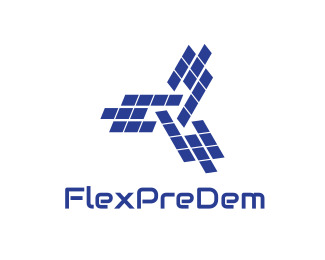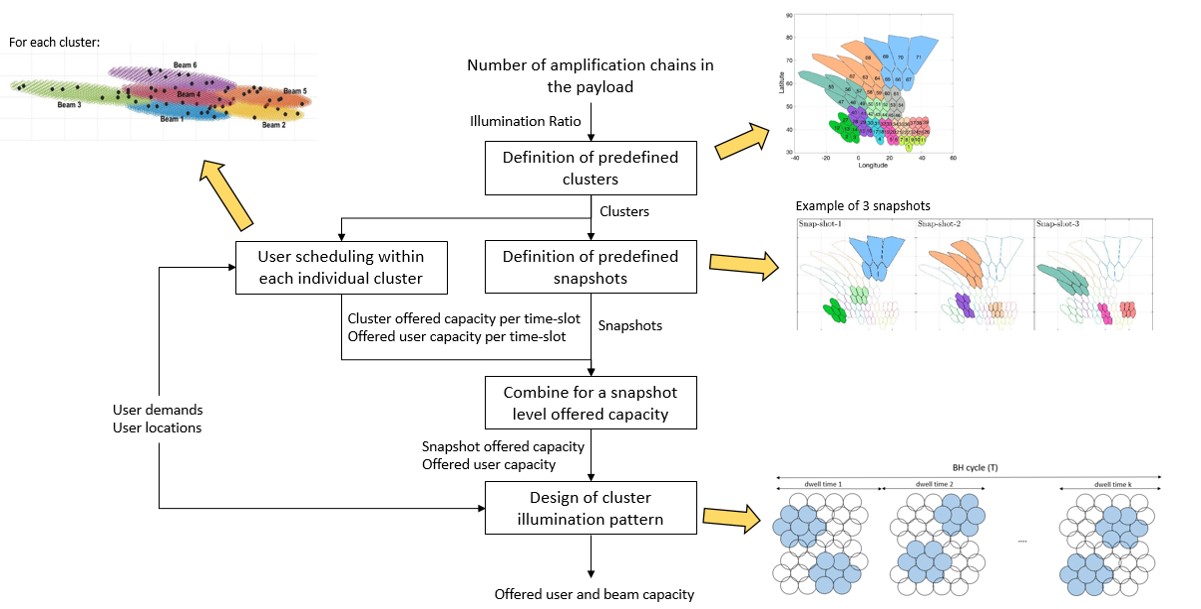
-
StatusOngoing
-
Status date2019-10-08
-
Activity Code3C.014
The proposed cluster hopping is designed from two different perspectives:
- Long-term flexibility: Aiming at the management and assignment of satellite resources according to the predicted beam traffic demands. This mainly focusses on the design of the appropriate illumination pattern so as to match the offered capacity with the average beam demands.
- Short-term flexibility: Once the illumination pattern is fixed, the optimization of the user scheduling within the clusters can further improve the overall traffic matching at a user-level. In this part, we show how the cluster-hopping approach provides another level of flexibility, where the resources of a cluster can be used to serve users on the cluster coverage area in a very flexible manner.

The introduction of precoding in beam–hopped systems allows the illumination of sets of adjacent beams with the same frequency resources. We define such set of adjacent beams as cluster and we refer to the concept of “Cluster Hopping”.
The design of the optimal illumination pattern, i.e. deciding which clusters to illuminate together and for how, is the key design challenge of FlexPreDem. In addition, the performance of cluster hopping strongly depends on the design of the cluster size and shape. Finally, the CSI estimation procedure (which is fundamental for the precoding part) needs to be adapted to the time-varying nature of the cluster hopping procedure.
Cluster hopping combines the benefits of beam hopping and precoding in a single technological solution. The hopping flexibility provides the means to adapt the offered capacity to the time and geographic variations of the traffic demands, while precoding exploits the multiplexing feature enabled by the use of multiple antenna feeds at the transmitter side to boost the spectral efficiency. These unique advantages become necessary when multiple beams are required to provide service to an area of high demand (hot-spot).
Beam hopping provides a high flexibility in satellite resource allocation among the beams in non-uniform or heterogeneous demand distribution scenarios. Some of the new additional features that arise with cluster hooping deployment in satellite systems are summarized as follows:
- Unlike conventional beam hopping, clustering hopping seamlessly combines beam hopping and precoding, and utilize their individual competencies.
- The proposed cluster hopping approach yields a beam-free paradigm (with a cluster) and can jointly serve any user within the cluster coverage.
- Cluster hopping with precoding can efficiently serve the heterogeneous demands over time and space, specifically when the spatial demand distribution is of cluster nature.

The satellite system is composed of the space segment which consists of a single GEO satellite, the ground segment consisting of multiple user terminals and a single GW, and the control segment that includes tracking, telemetry and command (TT&C) unit and a management unit for traffic and the associated resources onboard the satellite. The GW basically obtains the channel state information (CSI) from the users through the return link and performs the user scheduling, modulation, and coding (MODCOD) scheme selection and precodes the users’ data. A very important component of the satellite system is the resource manager (RM) that determines the hopping transmission plan that matches the capacity demands from the beams. The plan is communicated to the satellite via TT&C.
FlexPreDem spans over two years duration, starting in June 2018 and ending in May 2020.
The project is composed of four main tasks:
- Mission, System, Payload and Techniques Definition.
- FlexPreDem Design (Illumination Pattern Design and Scheduling).
- FlexPreDem Development, Validation and Integration.
- FlexPreDem Experimental Campaign.
The project is running as planned and the first milestone has been achieved in February 2019. Currently, the team is working on the FlexPreDem design, development and validation, which should be completed by September 2019.
The experimental campaign will take place during the last phase of the project.




